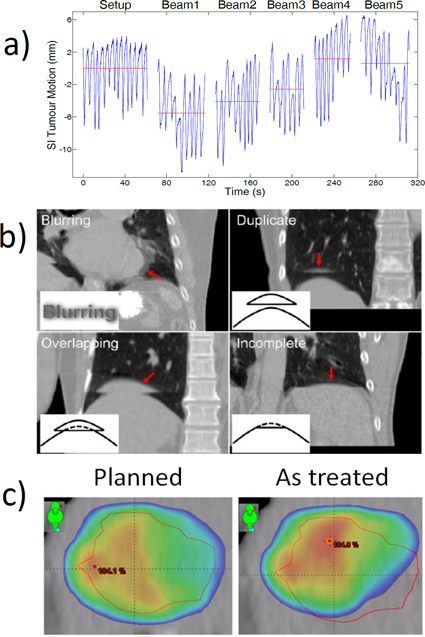AV Biofeedback
AV biofeedback is a simple, personalised and interactive respiratory guide designed to facilitate regular patient breathing. The AV biofeedback system is shown in figure 1.
Figure 1.

AV biofeedback system. Display screen and marker block on the abdomen shown. The visual display (centre) as seen by the subject (sans arrows) of the AV biofeedback system shows the guiding wave (white curve) and a marker position (marker block) in real time. The AV biofeedback system is compatible for both imaging (left) and treatment (right) environments.
The problem that AV biofeedback is addressing is that should a patient’s breathing be irregular (see Figure 2a), it can result in incorrect information presented in medical imaging (see Figure 2b). Such irregularities and image artefacts can lead to incorrect tumour targeting in radiotherapy (see Figure 2c) or an increase in the radiation target volume resulting in an increase in radiation dose delivered to healthy tissue. This may damage the healthy surrounding organs leading to loss of function and even cancer reoccurrence. This problem affects the 44% of the 10,200 lung cancer patients treated with radiotherapy in Australia, and up to 71% of the 1.2 million lung cancer patients treated with radiotherapy in the world each year.
Figure 2a.

Figure 3.

Comparison of free breathing and AV biofeedback breathing signals (top) and image quality for 4D-CT (middle) and gated-MRI (bottom). Arrows point out image artefacts due to irregular breathing.
A number of studies have already been performed demonstrating the effectiveness of AV biofeedback in reducing breathing irregularities in addition to improving image quality, demonstrated in Figure 3.
AV biofeedback is now at a crucial stage towards commercialisation. This will be achieved through comprehensive clinical evaluations and technology assessments of the AV biofeedback device in prospective, randomised multi-institutional clinical trials, involving both lung and liver cancer patients across a range of imaging modalities; these will be the most thorough and significant studies of their kind to date.
Such audiovisual biofeedback studies include:
Research Opportunities
For more information and enquiries contact Professor Paul Keall.

